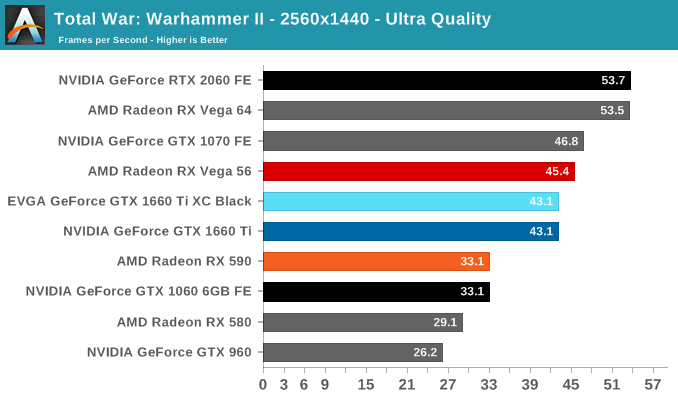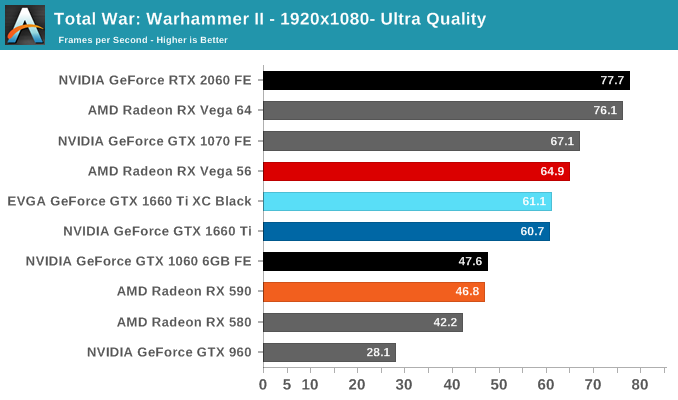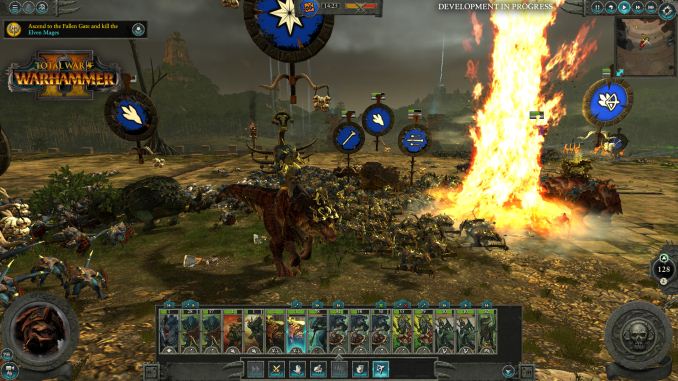The NVIDIA GeForce GTX 1660 Ti Review, Feat. EVGA XC GAMING: Turing Sheds RTX for the Mainstream Market
by Ryan Smith & Nate Oh on February 22, 2019 9:00 AM ESTTotal War: Warhammer II (DX11)
Last in our 2018 game suite is Total War: Warhammer II, built on the same engine of Total War: Warhammer. While there is a more recent Total War title, Total War Saga: Thrones of Britannia, that game was built on the 32-bit version of the engine. The first TW: Warhammer was a DX11 game was to some extent developed with DX12 in mind, with preview builds showcasing DX12 performance. In Warhammer II, the matter, however, appears to have been dropped, with DX12 mode still marked as beta, but also featuring performance regression for both vendors.
It's unfortunate because Creative Assembly themselves have acknowledged the CPU-bound nature of their games, and with re-use of game engines as spin-offs, DX12 optimization would have continued to provide benefits, especially if the future of graphics in RTS-type games will lean towards low-level APIs.
There are now three benchmarks with varying graphics and processor loads; we've opted for the Battle benchmark, which appears to be the most graphics-bound.


Rounding out our look at game performance is Total War: Warhammer II.
Here, the GTX 1660 Ti lags behind the RTX 2060 and GTX 1070 FE more than in the other games, offering only somewhere around 80% of the RTX 2060 speed and 90% of the GTX 1070. In turn, it doesn't improve as much upon the GTX 1060 6GB and GTX 960, though practically speaking it has rendered its RX 590 competition as last-generation performance, given that it's neck-and-neck with the GTX 1060 6GB FE.











157 Comments
View All Comments
Rudde - Friday, February 22, 2019 - link
Never mind, the second page explains this well. (Parallell execution of fp16, fp32 and int32)CiccioB - Saturday, February 23, 2019 - link
Not only that.With Turing you also get mesh shading and a better support for thread switching, which is a awful technique used on GCN to improve its terrible efficiency, having lots of "bubbles" in the pipelines.
That's the reason you see previous AMD optimized games that didn't run too well with Pascal work much better with Turing, as the high threaded technique (the famous AC which is a bit overused in engines created for the console HW) is not going to constantly stall the SM with useless work as that of frequent task switching.
AciMars - Saturday, February 23, 2019 - link
“Worse yet, the space used per SM has gotten worse“. not true.. you know, turing have separate cuda cores for int and fp. It means when turing have 1536 cuda cores means 1536 int + 1536 fp cores. So on die size actually turing have 2x cuda cores compare to pascalCiccioB - Monday, February 25, 2019 - link
Not exactly, the number of CUDA core are the same, just that a new independent ALU as been added.A CUDA core is not only an execution unit, it also registers, memory (cache), buses (memory access) and other special execution units (load/store).
By adding a new integer ALU you don't automatically get double the capacity as really doubling the number of a complete CUDA core.
ballsystemlord - Friday, February 22, 2019 - link
Here are some spelling and grammar corrections.This has proven to be one of NVIDIA's bigger advantages over AMD, an continues to allow them to get away with less memory bandwidth than we'd otherwise expect some of their GPUs to need.
Missing d as in "and":
This has proven to be one of NVIDIA's bigger advantages over AMD, and continues to allow them to get away with less memory bandwidth than we'd otherwise expect some of their GPUs to need.
so we've only seen a handful of games implement (such as Wolfenstein II) implement it thus far.
Double implement, 1 befor ()s and 1 after:
so we've only seen a handful of games (such as Wolfenstein II) implement it thus far.
For our games, these results is actually the closest the RX 590 can get to the GTX 1660 Ti,
Use "are" not "is":
For our games, these results are actually the closest the RX 590 can get to the GTX 1660 Ti,
This test offers a slew of additional tests - many of which use behind the scenes or in our earlier architectural analysis - but for now we'll stick to simple pixel and texel fillrates.
Missing "we" (I suspect that the sentence should be reconstructed without the "-"s, but I'm not that good.):
This test offers a slew of additional tests - many of which we use behind the scenes or in our earlier architectural analysis - but for now we'll stick to simple pixel and texel fillrates.
"Looking at temperatures, there are no big surprises here. EVGA seems to have tuned their card for cooling, and as a result the large, 2.75-slot card reports some of the lowest numbers in our charts, including a 67C under FurMark when the card is capped at the reference spec GTX 1660 Ti's 120W limit."
I think this could be clarified as their are 2 EVGA cards in the charts and the one at 67C is not explicitly labeled as EVGA.
Thanks
Ryan Smith - Saturday, February 23, 2019 - link
Thanks!boozed - Friday, February 22, 2019 - link
The model numbers have become quite confusingYojimbo - Saturday, February 23, 2019 - link
I don't think they are confusing, 16 is between 10 and 20, plus the RTX is extra differentiation. In fact if NVIDIA had some cards in the 20 series with RTX capability and some cards in 20 series without RTX capability, even if some were 'GTX' and some were 'RTX', then that would be far more confusing. Putting the non-RTX Turing cards in their own series is a way of avoiding confusion. But if they actually come out with an "1180" as say some rumors floating around, that would be very confusing.haukionkannel - Saturday, February 23, 2019 - link
Interesting to see the next year.Rtx 3050 and gtx 2650ti for the weaker version, if we get one new card rtx family... Hmm... that could work if They keep the naming. 2021 RTX3040 and gtx 2640ti...
CiccioB - Thursday, February 28, 2019 - link
Next generation all cards will have enough RT and tensor core enabled.